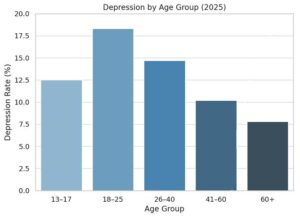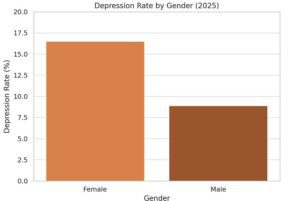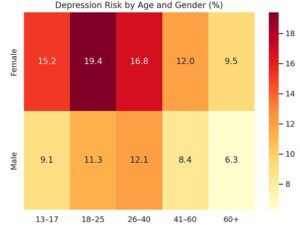
What Age Group Is Most Affected by Depression and Why?
What Age Group Is Most Affected by Depression
Depression is one of the most widespread mental health conditions in the world. Despite increased awareness and mental health literacy, millions still suffer in silence, unsure why they feel the way they do. To make prevention and treatment more effective, it’s important to understand who is most at risk—by age and gender—and why these differences exist.
In this blog, we’ll explore depression across different age groups, why women are more affected than men, and how psychological, hormonal, and societal factors contribute to this imbalance. We’ll also support our discussion with graphs and real-world data to give you a clearer picture.
Understanding Depression: A Brief Overview
Depression is more than just feeling sad or having a bad day. Clinically, it’s defined as a mood disorder that causes a persistent feeling of sadness, loss of interest, and various physical and emotional problems. According to the World Health Organization (WHO), depression affects more than 280 million people globally.
Common Symptoms Include:
- Low energy and fatigue
- Difficulty concentrating
- Sleep disturbances (insomnia or oversleeping)
- Changes in appetite or weight
- Feelings of worthlessness or guilt
- Thoughts of self-harm or suicide
What Age Group Is Most Affected by Depression?

According to global research and national health data, young adults between the ages of 18 and 25 report the highest rates of depression. This is closely followed by teenagers aged 13–17.
Age Group Breakdown:
| Age Group | Depression Rate (2025) |
|---|---|
| 13–17 | 12.5% |
| 18–25 | 18.3% |
| 26–40 | 14.7% |
| 41–60 | 10.2% |
| 60+ | 7.8% |
Why Is 18–25 the Most Affected Age Group?
- Academic and career pressure
- Transition to adulthood: independence, financial stress, identity crisis
- Social media comparison
- Romantic relationships and heartbreak
- Unstable job markets
This phase of life brings major shifts—emotionally, financially, and socially—making it especially vulnerable to depressive disorders.
Depression in Women: Understanding the Gender Gap
Multiple studies across decades consistently reveal that women are twice as likely to be diagnosed with depression compared to men.

Key Reasons for Higher Rates in Women:
- Biological and hormonal fluctuations – PMS, pregnancy, postpartum, and menopause all affect mood.
- Social stressors – Women often bear the brunt of domestic responsibilities along with careers.
- Greater emotional sensitivity – Societal norms allow women to express emotions more, making them more likely to report depression.
- Gender-based violence – Physical, emotional, and sexual abuse disproportionately affect women.
- Help-seeking behavior – Women are more likely to seek help, leading to more diagnoses.
Why Is Depression More Common Among Women Than Men?
Let’s break down some major contributing factors:
1. Hormonal Influence
Hormones like estrogen and progesterone fluctuate during menstruation, pregnancy, and menopause, affecting mood regulation and brain chemistry.
2. Postpartum Depression
Roughly 1 in 7 women experience postpartum depression after childbirth. This is due to both hormonal shifts and the emotional toll of new motherhood.
3. Role Strain
Women often juggle careers, caregiving, household duties, and social roles. This “double shift” significantly raises mental stress.
4. Social Expectations
Societal norms expect women to be emotionally nurturing, passive, and self-sacrificing, often pushing them to suppress their own mental needs.
Understanding Depression in Men
While women are diagnosed more, men often suffer silently. Depression in men is underreported due to stigma and traditional masculinity norms.
Unique Symptoms Often Seen in Men:
- Irritability and anger
- Substance abuse (alcohol, drugs)
- Risky behaviors
- Emotional withdrawal
- Suicidal thoughts or actions
Gender-Specific Symptoms of Depression
| Symptom | More Common in Women | More Common in Men |
|---|---|---|
| Sadness, crying | ✅ | ❌ |
| Loss of interest in activities | ✅ | ✅ |
| Substance abuse | ❌ | ✅ |
| Fatigue, low energy | ✅ | ✅ |
| Aggression, irritability | ❌ | ✅ |
| Seeking help | ✅ | ❌ |
Combined Risk: Age + Gender

Let’s analyze who is most at risk when age and gender are both considered.
| Age Group | Female (%) | Male (%) |
|---|---|---|
| 13–17 | 15.2 | 9.1 |
| 18–25 | 19.4 | 11.3 |
| 26–40 | 16.8 | 12.1 |
| 41–60 | 12.0 | 8.4 |
| 60+ | 9.5 | 6.3 |
What Can Be Done to Address This Crisis?
For Youth:
- Mental health education in schools
- Peer support groups
- Digital detox programs
- Accessible student counseling services
For Women:
- Routine screening during pregnancy and postpartum
- Safe spaces for victims of abuse
- Support groups focused on working mothers or caregivers
For Men:
- Breaking stigma around mental health
- Encouraging open conversations
- Screenings in workplaces and clinics
For Elderly:
- Community involvement
- Treatment of chronic illnesses
- Grief counseling
Conclusion
Depression does not discriminate—it can affect anyone. However, young adults, especially young women, are most at risk. The interplay of hormonal changes, societal expectations, and emotional pressure contributes significantly to this pattern.
Understanding the age and gender differences in depression is crucial to formulating better preventive strategies, treatment options, and support systems. Whether you are a parent, student, caregiver, or policy maker—awareness is the first step toward change.










